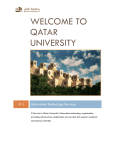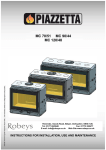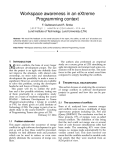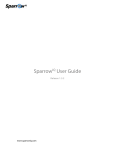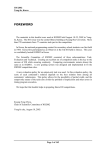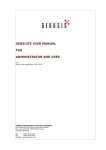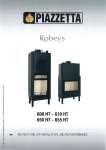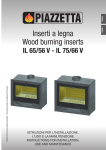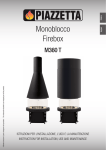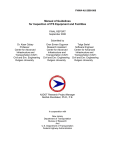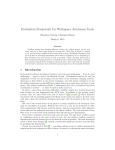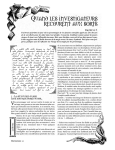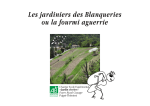Download Applying Cognitive Walkthrough to Evaluate the Design of
Transcript
Applying Cognitive Walkthrough to Evaluate the Design of SPIN Interface
Tengku Siti Meriam Tengku Wook, Hazura Mohamed, Hairuliza Mohd Judi, Noraidah
Applying Cognitive Walkthrough to Evaluate the Design of SPIN
Interface
Tengku Siti Meriam Tengku Wook, Hazura Mohamed, Hairuliza Mohd Judi, Noraidah
Sahari@Ashaari
School of Information Technology, National University of Malaysia, 43000 Bangi, Selangor,
Malaysia, {tsm,hazura,hmj,[email protected]},
Abstract
This study focuses on cognitive methods Walkthrough to measure the usability of SPIN interface
design. SPIN is an interactive online teaching and learning system that can be accessed by lecturers
and students of Universiti Kebangsaan Malaysia (UKM) through internet. The existing SPIN interface
design is difficult to access because of the different user interaction styles when browsing information
on SPIN. A "low-fidelity" prototype to the new SPIN interface was designed based on the design of
conceptual models that have been produced. Walkthrough cognitive methods applied in this study
involving a small group of professional designers and developers to evaluate the prototype interface
design new SPIN. Result of this study is a prototype of SPIN "high-fidelity" interface which can be
accessed by multiple groups of users.
Keywords: cognitive walkthrough, design interface, usability evaluation
1. Introduction
A cognitive walkthrough method becomes an important aspect of this study to measure the usability
of SPIN interface design which was developed through a mock-up of low-fidelity prototype. SPIN
works to help lecturers to interact with virtual students through interactive teaching and learning.
Among its functions; upload/download learning materials such as tutorials, quizzes, exercises, projects
and lecture notes, communicating through emails, conversations and discussions, announcements and
information display. Each pages of SPIN interface has links to each other, and many more teaching and
learning features that involves two users. Cognitive walkthrough exercise which has been carried out is
focusing on user’s mental operations manual and not the interface design characteristics. Problems can
be identified with more specific because it can connect user to the cognitive process features available
on the interface [1]. Cognitive walkthrough methods do not require the development of a fully
functioning system; it is implemented in the preliminary stage to save on repair costs that might be
occurred in future [2] and [3]. The objective of this study is to carry out the cognitive methods during
the initial stage of redesigning the SPIN interface based on the requirements that have been discovered
with students.
2. The Cognitive Walkthrough
The cognitive walkthrough methods have been implemented since 1990 [4], this method evaluates
user interface design that gives detailed attention to support an interface of a survey (exploratory
learning) [5]. Evaluation can be done by system designers in the early stages of design before running
the Empirical testing [2].
According to [5], a Cognitive walkthrough to evaluate usability is a combination of software
exploration and the cognitive learning model that can be explored. It is a theory structured evaluation
process that included in a set of questions in the questionnaire [6]. Each item was built to focus the
designer observation and individual aspects that help to make implicit decisions to solve problems [8].
Journal of Convergence Information Technology(JCIT)
Volume7, Number4, March 2012
doi:10.4156/jcit.vol7.issue4.13
106
Applying Cognitive Walkthrough to Evaluate the Design of SPIN Interface
Tengku Siti Meriam Tengku Wook, Hazura Mohamed, Hairuliza Mohd Judi, Noraidah
The cognitive walkthrough methods involves one or a group of respondents whose selected from a
particular background to test or explore (self-Exploration) the usability of interface design in an
application system [7]. A design evaluator is normally the experts, interface designers or any other
developers who have collaborated in the design and development processes [8].
The Cognitive walkthrough method was carried out on systems that have not been fully completed
(working state) or the mock-up system. It was conducted to improve the weaknesses in terms of user’s
understanding and acceptance of the interface design approach. Each part that does not give
understanding to the user will be identified and improved. According to [9], there are three procedures
for the implementation of cognitive Walkthrough methods: firstly, to explain briefly about the users
who will test the system and their academic background. Secondly, describe the tasks to be tested on
the system specifically. Finally, a list of tasks for user to complete the assignment.
3. SPIN Interface Design
SPIN interface design is based on the conceptual design model that has been produced by [10],
which involves explicitly the idea or the concept of user interface display. Conceptual design model
covers the SPIN interface interaction style. Table 1 shows the interaction style issues being
investigated along with a description of the interface SPIN.
Interaction Style Issue
Command line languages
Menu
Direct manipulation
Form fill-in
Question/answer and query
dialogue
WIMP Interface
Table 1. Interaction styles issues
Task
Users interact with the computer through the use of the language provided by
typing commands in SPIN applications using the keyboard, keywords or
instruction word.
Use of the SPIN interface menu such as pull-down menu, pop-up menu or menu
hierarchy.
Manual control icons or graphic objects that can be controlled by the user, such
as drag and drop objects (drag and drop) and the mouse pointer.
Users using the notification area or discussion and chat boards to communicate
SPIN users communicate with the applications via the search dialog box to
create a query to access information in the database.
Users are more comfortable using WIMP (windows, icons, menus and pointers /
pull down menu) while accessing SPIN.
3.1 Conceptual Design Method
Participatory design method (PD) [11] is used to develop the conceptual design of the interface
SPIN model involving lecturers and students as partners carried out in iterative design. It involves two
phases, namely: (1) explore the idea of early [12] (initial Exploration of work) and (2) discovery
process [13].
3.1.1 Explore Initial Idea
Exploring the initial idea involves six users, which are; three lecturers and three students. The
purpose of this phase is to get consumer reaction and opinion on the use of SPIN applications. The
technique used is observation and interview, which took 15 to 20 minutes per person. Before starting
the session, the user is given a description of the research objectives and their role as design partners.
Next, they were given the below task:
Task Lecturer / student:
1. upload / download the lecture notes
2. deliver announcements or instructions
3. implement the relevant features
4. communicate with students / lecturers
107
Applying Cognitive Walkthrough to Evaluate the Design of SPIN Interface
Tengku Siti Meriam Tengku Wook, Hazura Mohamed, Hairuliza Mohd Judi, Noraidah
3.1.1.2 Exploring Initial Idea Analysis
Table 2 shows the analysis and output of the reaction and views as the issue of consumer interaction
styles. The list is compiled based on the duplication of information.
Interaction Style
Issue
Command line
languages
Table 2. User’s reaction and suggestion
Lecturer’s Opinions and Suggestion Student’s Opinions and Suggestion
Different instruction for each set
confused the user
Need to enter a complete staff
identification number for login, differ
from other UKM information system.
Menu
Direct manipulation
Form fill-in
Question/answer and
query dialogue
WIMP Interface
Not able to access all student emails in
the course taken
Features such as quizzes, tutorials,
training and project can only be
viewed but not manipulated.
Admin unable to access all sets of
group teaching aids.
Courses cannot be search by
keywords. Only document for the particular
semester can be accessed. Any lecture
notes or item transfer is quite
complicated.
The information display did not specify
status of students, either undergraduate
or graduate, and their semester
Does not understand the abbreviation
used for faculty in the “pull down”
menu.
Unable to update student profile except
for mobile phone number and email
address.
Students are unable to browse
information remotely.
Feature “Launch Learning Objects &
communication” is displayed but left
unused.
Sometimes an announcement from other
lecturer which is not related to the course
appears on the screen.
Student unable to send email to each
other individually, except to those who
register for the course.
Feature “fast download” unable to
download a complete set of lecture notes.
Information displayed include the
calendar but with no time.
Information on lecture hall without the
building details.
Inconsistent used of language, all topics
are in English but the courses name are
in Malay.
As shown in Table 2, there is much confusion on the display of content which led to difficulties for
user to access the information on SPIN. The language used for instruction is inconsistent and unclear as
the selection set in the course. “Pull down" menu is used to view faculty has increased consumer
confusion because the acronym used is not provided with a description. SPIN applications are not
flexible because users can not directly manipulate information, such as student email information will
not be shown for the lecturer to contact the desired student and administrator cannot reach all the set of
courses in the teaching group. Features "Launch Learning Objects & communication" has no function.
However, the WIMP interface style of interaction is not a problem faced by the lecturers, but students
who are confused about the information display on lecture classes and language used on the courses
offered.
3.1.2 Discovery Process
Discovery process is the second cycle after the input from the initial idea of exploring phase. Users
are divided into a group of four combining lecturers and students. The technique used was
brainstorming through the workflow model and analyze the interface SPIN session. The time allocated
108
Applying Cognitive Walkthrough to Evaluate the Design of SPIN Interface
Tengku Siti Meriam Tengku Wook, Hazura Mohamed, Hairuliza Mohd Judi, Noraidah
is 30 minutes. Work flow model is based on interaction style issues that have been analyzed in the first
phase. The SPIN interface analysis session began with an interactive brainstorming within groups.
Everyone in the group play a role to give opinions and to record findings.
3.1.2.1 Discovery Process Analysis
Table 3 below shows the analysis and the output gathered by users during the brainstorming session.
Table 3. User’s suggestion
Suggestion
Interaction Style
Issues
Command line
languages
The usability in terms of information delivery can be improved such as:
o Flexible used of staff number or the last four digits to enter the SPIN
application
o No need to create an additional set into the timetable to visualize it.
o Indicate the status of students in the feature "view profile"
Menu
There must be a legend for each letter stands for, or
The full list of faculty names in the menu "pull-down"
Direct manipulation
Form fill-in
question/answer and
query dialogue
WIMP Interface
The usability in terms of information delivery can be improved such as:
o Display registered students’ emails hierarchy.
o Features displayed to help user to control the information.
o Student can access SPIN application remotely.
The efficiency of database can be enhanced so that:
o Admin can control all sets in the courses
o The courses can be searched via keyword
o Student can send personal email to each
Student can access a complete set of lecture notes through the “fast download”
feature.
There is a menu that allows transferring lecture aid to the new semester.
Add the information of:
o Time
o Building name and label
o Consistency of language used
Table 3 describes the findings on how to improve the usability by reorganize information on SPIN
interface. The misunderstanding can be resolved by removing unused features like "launch learning
objects and communication". Use the "pull-down" to display a full list of faculty names clearly not just
use the acronym alphabet only. Consumerism manipulation and form filling are inter-related because it
involves a visual guide. Menus or functions that allow administrators / lecturers should be provided to
facilitate the manipulation of the content. Users can manipulate features such as answering quiz
questions via the interface and SPIN database will generate and display the results on the interface.
WIMP interface should be clear by adding a label, clock icon to show time and consistent use of
language.
3.1.3 Findings
Research on initial idea exploration and discovery process with users produces the conceptual
design of the SPIN interface, which represents by a mind mapping of information architect and user.
The SPIN conceptual design helps to reorganize the information. RP method is used to get the right
mind mapping model, which is in accordance with user requirement. Figure 1 shows a schematic
structure of the research conceptualization. There are three levels:
1. Six styles of user interaction on SPIN interface
2. Summary of user reaction and opinion on the SPIN interface interaction style by category
3. Summary of users’ suggestion to support their reaction and opinion
109
Applying Cognitive Walkthrough to Evaluate the Design of SPIN Interface
Tengku Siti Meriam Tengku Wook, Hazura Mohamed, Hairuliza Mohd Judi, Noraidah
Interaction Style
SPIN
INTERFAC
CE
User’s suggestion
Reaction and point
of view on SPIN
interface
Comman
nd line
languag
ges
Confusin
ng
Instruction
Inconsis
stent
Instruction
Direct
on
manipulatio
Menu
F
Features can nott be
c
controlled
T
There are feature
es that
d
do not work
Form ffill-in
Questtion /answer and
query dialogue
Re
estructuring
Inefficient database
Poor access
document
WIMP
Interface
Display
incomplete
document
Menu is no
ot
clear
Flexible use
e of employee
numbers
Add space for the visual
information
n
Specify the status of the “vie
ew
profile”
Provid
de a feature
that ca
an be
contro
olled
Can a
access mobility
N
Need a legend
S
Show full details
Can control the course set
Course acce
essibility
through keyw
words.
Can email in
ndividually or in
groups
Improve the
interface by th
he
labels and icon
ns
The complete no
ote uploaded
through the fast download
u/function transfe
er
There is a menu
lecture notes
Figure 1. Research Schem
matic Structure
3.1..4 “Low-fideelity” Protottype
A mock up iinterface desiign was developed as a "low-fidelity" prototype tto accelerate the
deveelopment proccess iterativelyy. The purposse of SPIN intterface is to im
mplement the conceptual model
that has been prodduced. SPIN iinterface emphhasizes on dessign and buttoon as required in the concepptual
desiign model. Figgures 2 to 7 aare some exam
mples of SPIN
N interface whhich have beeen developed. The
interrface represennts the lecturerrs / UKM stafff selection on courses activities, profile, aand lecture nottes.
Figure 2. SPIN main interface
Figure 3. UK
KM staff profilles interface
F
Figure
2 show
ws SPIN main interface thatt contains three buttons whhich are lecturrers, students and
userr manual. Useers can log intto the system using either their complete employee nnumber or the last
fourr digits. Figurre 3 portrays UKM staff prrofiles, users can update prrofiles, changge the picture and
channge the password options.
110
Applying Cognitive Walkthrough to Evaluate the Design of SPIN Interface
Tengku Siti Meriam Tengku Wook, Hazura Mohamed, Hairuliza Mohd Judi, Noraidah
Figure 4. Courses profi
file interface
Figure 5. L
Lecturers profille interface
F
Figure
4 illustrrates the coursses profile, a cclear label on tthe icon descrribes information on the couurse.
Lectturers are ablee to manage thhe set of courses easily. Figuure 5 shows thhe lecturers proofile can be eaasily
updaated.
Figure 6.. Upload coursse interface
Figure 77. Activities innterface
F
Figure
6 show
ws an interfacee to upload thee course usingg friendly iconns and labels. Lecturers cann use
the transfer funcction of the lecture notes before the neew semester begins. Figurre 7 displays the
activvities interfacee which uses iicons and labeels as a commuunication toolss between lectturer and studeent.
3.1..5 Summaryy
Interface desiggn with the higgh accessibilitty is importantt because it is user friendly and ready forr use
by aall users, incluuding people w
with disabilitiees. Interface design
d
must haave a balance usability feattures
in teerms of functioons and the innformation conntained herein..
4. C
Cognitive w
walkthrough
h evaluatioon
T purpose oof cognitive w
The
walkthrough evvaluation is to improve the SPIN interfacce design term
ms of
userr acceptance aand understandding of interfa
face design appproach. Resullts of this reseearch will hellp to
deveelop a high-fiddelity prototyppe as a final pproduct. Interfa
face design thaat does not hellp much on ussers’
undeerstanding willl be identifiedd and enhanceed.
4.1 Methods
T
The
cognitivee walkthroughh method invvolves the suubject matter experts as participants,
p
thhree
lectuurers and threee graduate stuudents work ttogether to givve comments and critique oof SPIN interrface
desiign. Specific ttasks to be caarried out by the
t participantts through thee four phases of the evaluaation
proccess are:
P
Phase
1: "Will the user try too achieve the right
r
effect?"
U
Users
will deciide their objecctives when ussing the SPIN interface.
E
Example:
Readding informatiion available oon the screen tto understand the system gooal.
111
Applying Cognitive Walkthrough to Evaluate the Design of SPIN Interface
Tengku Siti Meriam Tengku Wook, Hazura Mohamed, Hairuliza Mohd Judi, Noraidah
Phase 2: "Will the user notice that the correct action button is available?"
Users find the option buttons or objects to click or the space to insert text.
Example: Login button, text field, hyperlink, link.
Phase 3: "Will the user associate the correct action with the effect to be achieved?"
Users choose a task that they understood and try to explore the system.
Example: fill in the space text field and password to log into the SPIN system.
Phase 4: "If the correct action is performed, will the user see that progress is being made toward
solution of the task?"
Users do task and describe how the SPIN system response for the request.
Example: Pressing the Log in button and access to the next page
4.1.1 Procedures
Sequences of specific tasks performed by users during the cognitive Walkthrough session are as
below:
1. Enter the ID along with their password on the main page and press login button on SPIN system.
2. After login, users will see a lot of hypertext selection in the Menu Bar, and will explore the pages
randomly.
3. In HOME menu, the user will scan all the notifications listed. Users will route the cursor to find
out whether it can re-direct to another page or not.
4. In the PROFILE menu, the user will see the list of the menu list on the left side of the page and
press each button to find out more information.
5. In Menu COURSES, users will find a choice of courses to be seen and clicking on the selection
of courses is displayed. After entering a page that represents a course, the user's attention will
focus on the menu list on the left of the page.
6. In Menu USER MANUAL, the user will press the icon to download the SPIN user guide which is
provided in PDF format.
7. To exit the system, user will choose the YES or NO button at the LOG OUT menu.
8. Generally, the user's responses to all buttons or a direct hypertext links provided on each page
will be observed. It is to ensure the accuracy of each design and reflects the functions they
represent
4.2 Analysis and findings
Table 4 shows the results of cognitive Walkthrough methods conducted on students and lecturers
for the evaluation of the initial design of the SPIN prototype. Each of the lecturers and students to
respond either agree or disagree with the design of the interface that has been developed based on the
arrangement of features designed as a percentage. Most of the features developed satisfy by both
categories of participants. In terms of color features, all students agree with all color attributes while
33.33% and 66.67 % lecturers agree with the background and button colors respectively. 66.67% of
lecturers agree on calendar and expiry session of the SPIN, while none of the students show their
agreements.
112
Applying Cognitive Walkthrough to Evaluate the Design of SPIN Interface
Tengku Siti Meriam Tengku Wook, Hazura Mohamed, Hairuliza Mohd Judi, Noraidah
Criteria
Colours
Font
Button
Calendar
Interface
Expiry
Session
Icon
Menu
Selection
Menu List
Feature
Table 4. Percentage of interest on design criteria
Description
Lecturer
Student
1. A blue background to display information
2. Text
3. Hypertext button
1. Font type on text
2. hypertext font
1. Used of image as a button
1. Remain
2. Permanent at each page
1. layout consistency on each features
2. Layout design
3. Used of colour
1. Automatic logout if no cursor movement
33.33
66.67
100
66.67
66.67
100
66.67
66.67
100
100
66.67
66.67
100
100
100
66.67
66.67
100
0
0
100
100
66.67
0
1. Help user to understand the function of button
2. Icon can be selected with hypertext
3. Animation on icon
1. Location on layout
2. Used of colour
1. Location on layout
2. Change of font colour when hover the cursor
3. Hide and click to show
4. Differentiate between hypertext and hyperlink
1. Announcement will be deleted automatically
2. Quizzes
3. Questions Bank
4. Discussion Board
5. Pending subject
6. Viewers counter
7. Upload file
8. Status can be change from online to offline
100
100
33.33
100
100
100
0
100
66.67
100
100
66.67
100
66.67
100
100
100
100
100
100
100
100
100
66.67
100
100
100
100
66.67
100
0
0
100
100
Based on the cognitive walkthrough exercise, some suggestions for improvement have been
proposed by participants. Table 5 shows the suggestions pertaining features that should be considered
in developing a "high-fidelity" prototype. Among the suggestions are to improve the prototype color,
font and expiry session criteria. Regarding colour criterion, the prototype should use UKM corporate
colour and should follow the standard guidelines in text colour. The designer should differentiate font
on text and hyperlink and follow font standard guidelines. For expiry session criteria, participants
suggest that enough time should be estimated.
113
Applying Cognitive Walkthrough to Evaluate the Design of SPIN Interface
Tengku Siti Meriam Tengku Wook, Hazura Mohamed, Hairuliza Mohd Judi, Noraidah
Table 5. Improvement Suggestion
Description
Proposed Improvement
Criteria
Colour
Font
1. A blue background to display information
2. Text
1. Font type on text
Button
2. Font on hypertext
1. Used of image as a button
Calendar
Interface
1. Remain unchanged
1. Used of colour
Expiry
Session
Icon
1. Automatic logout if no cursor movement
Menu
List
1. Change of font colour when hover the cursor
1. Animation on icon
2. Differentiate between hypertext and hyperlink
Feature
1. Announcement will be deleted automatically on
certain timeline 2. Upload file
Use UKM corporate colour
Follows standard guidelines in text
Differentiate font on text and
hyperlink
Standardize font for other criteria
Icon can be clicked to redirect with
hypertext
To remain
Customize colour according to user
group (lecturer/student)
Estimate enough time
Minimal animation (zoom-in and
hover the cursor)
Change combination of colour to
be more contra
Remain the format for hyperlink to
avoid confusion
Remain as in the old format
Add in few more categories; notes,
tutorial, exercises etc
5. Conclusion
The SPIN interface design can be developed iteratively through the implementation of cognitive
Walkthrough method. Evaluation resulted from the SPIN interface prototype can help to improve the
weaknesses of this study in terms of lecturers and students understanding and acceptance of the actual
interface design approach. Cognitive Walkthrough method can also help to ensure the SPIN interface
design meets the user mind mapping model, which identifies part of design that usually being
misunderstood by lecturer and student.
6. References
[1] Blackmon, M.H., Polson P. G., Kitajima, M., and Lewis, C., “Cognitive Walkthrough for the web”,
In Proceeding of the Conference on Human Factors in Computing Systems Polson et al., Kitajima
1992, ACM, USA, 2002.
[2] Green, T., R., G., Burnett, M., Ko, A. J., Rothermel, K,. J., Cook, C., R., and Schonfeld J., “Using
the Cognitive Walkthrough to Improve the Design of a Visual Programming Experiment”, In
Proceeding of the 2000 IEEE International Symposium on Visual Language (VL ’00), IEEE
Computer Society, USA, pp. 172, 2000
[3] Allendoerfer, K.., Aluker, S., Panjwani, G., Proctor, J., Sturtz, D., Vukovic, M., and Chaomei Chen,
“Adapting the Cognitive Walkthrough Method to Assess the Usability of a Knowledge Domain
Visualization”, In Proceeding of the IEEE Symposium on Information Visualization, Drexel
University, 2005
[4] John, B. E., and Packer, H., “Learning and using the cognitive walkthrough method: A case study
approach”, In Proceedings of CHI 95, ACM, .New York, pp. 429-436, 1995
[5] Storey, M.-A.D and Muller H.A. (1999). "Cognitive design elements to support the construction of
a mental model during software exploration." The Journal of Systems and Software Vol. 44: 171185.
114
Applying Cognitive Walkthrough to Evaluate the Design of SPIN Interface
Tengku Siti Meriam Tengku Wook, Hazura Mohamed, Hairuliza Mohd Judi, Noraidah
[6] Rizzo, A., Marchigiani, E., and Andreadis, A., “The AVANTI Project: Prototyping and evaluation
with a Cognitive Walkthrough based on the Norman's model of action. In Proceeding of the
Conference on Designing Interactive Systems ’97, ACM, Amsterdam, 1997
[7] Rieman, J., Franzkc, M., and Redmiles, D., “Cognitive Walkthroughs: A Method for Theory-Based
Evaluation of User Interfaces”, In Proceeding of the Conference on Human Factors in Computing
Systems, ACM, USA, 1995
[8] Sung Heum Lee, "Usability Testing for Developing Effective Interactive Multimedia Software:
Concepts, Dimensions, and Procedures." Educational Technology &Society, vol. 2, no. 2, 1999
[9] Mowat, J., “Cognitive Walkthroughs : Where they came from, what they have become, and their
application to EPSS design”. The Herridge Group Inc., pp. 6-12, 2002
[10]Tengku Siti Meriam and Siti Salwa Salim, “Exploring children s requirements for the graphic
design of WebOPAC”, 14th International Conference, Lecture Notes in Computer Science 6764,
Springer Verlag, USA, pp. 627-63, 2011
[11]Moraveji, N., “User interface designs to support the social transfer of web search expertise” SIGIR
2010, Switzerland, pp. 915
[12] Jiagen SHENG , Sifeng LIU , "A Knowledge Recommend System Based on User Model",
JDCTA: International Journal of Digital Content Technology and its Applications, Vol. 4, No. 9, pp.
168-173, 2010
[13] Gu Zhenyu, He Yan, Li Nan, "A Case-based Green Design Support System for Customization
Product", AISS: Advances in Information Sciences and Service Sciences, Vol. 3, No. 10, pp. 176183, 2011
115











